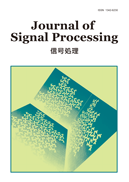
- |<
- <
- 1
- >
- >|
-
Yutaro Matsui, Shoji Makino, Nobutaka Ono, Takeshi Yamada2023Volume 27Issue 1 Pages 1-6
Published: January 01, 2023
Released on J-STAGE: January 01, 2023
JOURNAL FREE ACCESSIn this paper, we propose a novel approach to noise suppression using multiple distributed recording devices with stereo microphones. In the proposed method, noise suppression based on phase information is applied to the synchronous stereo signals captured by each recording device and then output signals are utilized for transfer-function-gain nonnegative matrix factorization (NMF) as extra input signals. We intended to estimate the target signal more accurately by transfer-function-gain NMF. Experiments using impulse responses measured in a meeting room have shown that the proposed method outperformed conventional methods using transfer-function-gain NMF in terms of the signal-to-distortion ratio (SDR) and signal-to-interference ratio (SIR).
View full abstractDownload PDF (825K) -
Kazuo Komatsu, Hitoshi Takata2023Volume 27Issue 1 Pages 7-15
Published: January 01, 2023
Released on J-STAGE: January 01, 2023
JOURNAL FREE ACCESSThis paper is concerned with a nonlinear filter for a general class of nonlinear time-varying systems, by making use of a pseudo-formal linearization method and Kalman filter approach. The given nonlinear time-varying dynamic and measurement equations are piecewisely linearized by the formal linearization method using Taylor expansion so that Kalman filter can be applied for each linearized time-varying equations. Then the resulting filters are smoothly united into a single nonlinear filter by an automatic choosing function. The efficiency of this filter is shown through numerical examples.
View full abstractDownload PDF (903K) -
Hiroki Kishi, Pitoyo Hartono2023Volume 27Issue 1 Pages 17-27
Published: January 01, 2023
Released on J-STAGE: January 01, 2023
JOURNAL FREE ACCESSIn nature, pain is one of the most important signals to preserve life for humans and animals. The unpleasantness of pain is a signal for a dangerous situation that should urgently be resolved. While humans experience many degrees of pain, and even use it for interacting with their living environments in daily life, there are few studies that utilize pain as an interface between human and their surrounding environment including machines. In this study, we develop a device to generate illusion of pain by using the “thermal grill illusion” caused by temperature stimulation on human skin. The objective of this research is to develop a new modality for interaction between humans and machines using illusion of pain, and to test the interface for remote operation of robot. The proposed interface induces a temporary illusion of mild pain on human skin without inflicting any injuries. The proposed interface enables humans to interact with machines including remotely located robots that convey their unfavorable situations in the form of pain-illusions that is directly sensed by humans. In this paper, the hardware platform for the pain-illusion generating device will be elaborated. The efficacy of the proposed interface will be evaluated through remote operation of mobile robot.
View full abstractDownload PDF (1289K) -
28. Mathematical Consideration of Linear Equation Derived from One-Dimensional Maxwell EquationsNobuo Nagai, Hirofumi Sanada, Takashi Yahagi2023Volume 27Issue 1 Pages 29-34
Published: January 01, 2023
Released on J-STAGE: January 01, 2023
JOURNAL FREE ACCESSAbstract Partial reflection is an electromagnetic phenomenon that occurs concurrently with refraction, but the presence of partial reflection is ignored in the variational calculus, which is frequently used to analyze electromagnetic phenomena in physics. In mathematics, Fuchs functions were derived from wave equations without considering partial reflection, and modular forms were then derived from the Fuchs functions. It is shown in this session that the cascade matrices used in circuit theory are expressed using two functions with duality, that is, voltage and current, serve as a mathematical tool expressed by a linear combination existing in an identical space, and have a modular form. In future work, it is expected that new functions and actions of the cascade matrices with a modular form and duality can be clarified through their application to electromagnetics and quantum mechanics.
View full abstractDownload PDF (852K)
- |<
- <
- 1
- >
- >|